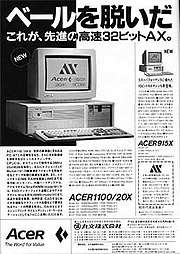AX architecture
AX (Architecture eXtended) was a Japanese computing initiative starting in around 1986 to allow PCs to handle double-byte (DBCS) Japanese text via special hardware chips, whilst allowing compatibility with software written for foreign IBM PCs. It was developed by a consortium including ASCII Corporation, Sony, Hitachi, Sharp, Oki, Casio, Canon, Kyocera, Sanyo, Mitsubishi Electric, etc. with cooperation of Microsoft. but notably excluding Toshiba and Fujitsu (who were hence the 'opposition'). At that time, NEC PC-9801 was the dominant PC architecture in the Japanese PC market because IBM PC/AT and its clone PCs could not display Japanese text. However, NEC did not tolerate PC-9801 compatible machines and was fighting court battles with Epson which was the only PC-9801 compatible machine vendor. Therefore other vendors desperately needed a standard specification for Japanese capable PCs.
.jpg)

To display Kanji characters with sufficient clarity, AX machines had JEGA screens with a resolution of 640x480 rather than the 640x350 standard EGA resolution prevalent elsewhere at the time. Users could typically switch between Japanese and English modes by typing 'JP' and 'US', which would also invoke the AX-BIOS and an IME enabling the input of Japanese characters.
However, soon after the release of the AX, IBM released the VGA standard with which AX was obviously not compatible (they were not the only one promoting non-standard "super EGA" extensions). Consequently, the AX consortium had to design a compatible AX-VGA. AX-VGA/H was a hardware implementation with AX-BIOS, whereas AX-VGA/S was a software emulation.
Due to less available software and more pricey than PC-9801 series, AX failed and was not able to break into the market in Japan. The Nikkei Personal Computing journal reported in 1989 that only 18 out of 36,165 PCs used in 937 companies were AX machines, and 90% of companies had no plan to purchase the AX machine.[1]
In 1990, IBM Japan unveiled DOS/V which enabled IBM PC/AT and its clones to display Japanese text without any additional hardware using a standard VGA card. Soon after, AX disappeared and the decline of NEC PC-9801 began.
See also
References
- 松岡, 資明; 中川, 貴雄; 礒田, 温之; 西村, 裕 (1989-04-10). "調査:パソコン・シェア 企業はPS/55、家庭はPC-9800". 日経パソコン (in Japanese). Nikkei Business Publications: 280–281. ISSN 0287-9506.
Further reading
- Myers, Steven; Smith, Greg (March 1995). "DOS/V: The Soft(ware) Solution to Hard(ware) Problems". Computing Japan Magazine. Archived from the original on 2017-01-15. Retrieved 2017-01-15.
- Boyd, John (April 1997). "From Chaos to Competition - Japan's PC industry in transformation". Computing Japan Magazine. Archived from the original on 2017-01-16. Retrieved 2017-01-16.
- Dünßer, Elmar (2015) [2005]. "Die AX Computer (Japan) - 1988-1993" (in German). Archived from the original on 2017-01-17. Retrieved 2017-01-16.
External links
- Mitsubishi Maxy (information from a Japanese computer museum)
- Oki if386AX (information from a Japanese computer museum)